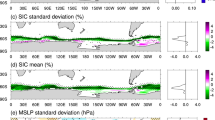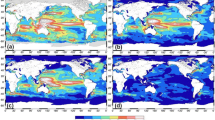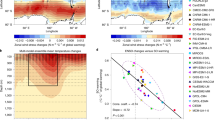Abstract
Based on a novel design of coupled model simulations where sea surface temperature (SST) variability in the equatorial tropical Pacific was constrained to follow the observed El Niño—Southern Oscillation (ENSO) variability, while rest of the global oceans were free to evolve, the ENSO response in SSTs over the other ocean basins was analyzed. Conceptually the experimental setup was similar to discerning the contribution of ENSO variability to interannual variations in atmospheric anomalies. A unique feature of the analysis was that it was not constrained by a priori assumptions on the nature of the teleconnected response in SSTs. The analysis demonstrated that the time lag between ENSO SST and SSTs in other ocean basins was about 6 months. A signal-to-noise analysis indicated that between 25 and 50 % of monthly mean SST variance over certain ocean basins can be attributed to SST variability over the equatorial tropical Pacific. The experimental setup provides a basis for (a) attribution of SST variability in global oceans to ENSO variability, (b) a method for separating the ENSO influence in SST variations, and (c) understanding the contribution from other external factors responsible for variations in SSTs, for example, changes in atmospheric composition, volcanic aerosols, etc.










Similar content being viewed by others
References
Alexander MA, Scott JD (2002) The influence of ENSO on air–sea interaction in the Atlantic. Geophys Res Lett 29. doi:10.1029/2001GL014347
Alexander MA, Bladé I, Newman M, Lanzante JR, Lau N-C, Scott JD (2002) The atmospheric bridge: the influence of ENSO teleconnections on air–sea interaction over the global oceans. J Clim 15:2205–2231
Barnston AG (1994) Linear statistical short-term climate predictive skill in the Northern Hemisphere. J Clim 7:1513–1564
Barnston AG, Chelliah M, Goldenberg SB (1997) Documentation of a highly ENSO-related SST region in the equatorial Pacific. Atmos Ocean 35:367–383
Behringer DW, Xue Y (2004) Evaluation of the global ocean data assimilation system at NCEP: the Pacific Ocean. Preprints, Eighth Symposium on integrated observing and assimilation systems for atmosphere, oceans, and land surface, Seattle, WA, USA. Meteor. Soc. 2.3. Available online at http://ams.confex.com/ams/84Annual/techprogram/paper_70720.htm
Chang P, Fang Y, Saravanan R, Ji L, Seidel H (2006) The cause of the fragile relationship between the Pacific El Niño and the Atlantic Niño. Nature 443:324–328
Chen J, Del Genio AD, Carlson BE, Bosilovich MG (2008) The spatiotemporal structure of twentieth-century climate variations in observations and reanalyses. Part I: Longterm trend. J Clim 21:2611–2633
Chen M, Wang W, Kumar A, Wang H, Jha B (2012) Ocean surface impacts on the seasonal-mean precipitation over the tropical Indian Ocean. J Clim 25:3566–3582
Chiang JCH, Lintner BR (2005) Mechanisms of remote tropical surface warming during El Nino. J Clim 18:4130–4149
Chiang JCH, Sobel AH (2002) Tropical tropospheric temperature variations caused by ENSO and their influence on the remote tropical climate. J Clim 15:2616–2631
Compo GP, Sardeshmukh PD (2010) Removing ENSO-related variations from the climate record. J Clim 23:1957–1978
Elliott JR, Jewson SP, Sutton RT (2001) The impact of the 1997/98 El Niño event on the Atlantic Ocean. J Clim 14:1069–1077
England MH, Huang F (2005) On the interannual variability of the indonesian through flow and its linkage with ENSO. J Clim 18:1435–1444
Fu R, Liu WT, Dickinson RE (1996) Response of tropical clouds to the interannual variation of sea surface temperature. J Clim 9:616–634
Goddard L, Graham NE (1999) The importance of the Indian Ocean for simulating precipitation anomalies over eastern and southern Africa. J Geophys Res 104:19099–19116
Hoerling MP, Kumar A, Zhong M (1997) El Niño, La Nia and the nonlinearity of their teleconnections. J Clim 10:1769–1786
Horel JD, Wallace JM (1981) Planetary scale atmospheric phenomena associated with the Southern Oscillation. Mon Weather Rev 109:813–829
Huang B (2004) Remotely forced variability in the tropical Atlantic Ocean. Clim Dyn 23:133–152
Huang B, Shukla J (2007) Mechanisms for the Interannual variability in the tropical Indian Ocean. Part II: Regional processes. J Clim 20:2937–2960
Ji M, Kumar A, Leetmaa A (1994) Development of seasonal climate forecast system using coupled ocean–atmosphere model at National Meteorological Center. Bull Am Meteorol Soc 75:569–577
Jones PD (1988) The influence of ENSO on global temperatures. Clim Monit 17:80–89
Kanamitsu M, Ebisuzaki W, Woollen J, Yang S-K, Hnilo JJ, Fiorino M, Potter GL (2002) NCEP–DOE AMIP-II reanalysis (R-2). Bull Am Meteorol Soc 83:1631–1643
Kelly PM, Jones PD (1996) Removal of the El Niño Southern Oscillation signal from the gridded surface air temperature data set. J Geophys Res 101:19013–19022
Klein SA, Soden BJ, Lau N-C (1999) Remote sea surface temperature variations during ENSO: evidence for a tropical atmospheric bridge. J Clim 12:917–932
Kumar A, Hoerling MP (1995) Prospects and limitations of seasonal atmospheric GCM predictions. Bull Am Meteorol Soc 76:335–345
Kumar A, Hoerling MP (1997) Interpretation and implications of observed inter-El Niño variability. J Clim 10:83–91
Kumar A, Hoerling MP (2000) Analysis of a conceptual model of seasonal climate variability and implications for seasonal predictions. Bull Am Meteorol Soc 81:255–264
Kumar A, Hoerling MP (2003) The nature and causes for the delayed atmospheric response to El Nino. J Clim 16:1391–1403
Kumar A, Yang F, Goddard L, Schubert S (2004) Differing trends in the tropical surface temperatures and precipitation over land and oceans. J Clim 17:653–664
Kumar A, Jha B, L’Heureux M (2010) Are tropical SST trends changing the global teleconnection during La Niña? Geophys Res Lett 37:L12702. doi:10.1029/2010GL043394
L’Heureux M, Collins D, Hu Z-Z (2013) Linear trends in sea surface temperature of the tropical Pacific Ocean and implications for the El Niño-Southern Oscillation. Clim Dyn. doi:10.1007/s00382-012-1331-2
Lanzante JR (1996) Lag relationships involving tropical sea surface temperatures. J Clim 9:2568–2578
Lau N-C, Nath MJ (1996) The role of the “atmospheric bridge” in linking tropical Pacific ENSO events to extratropical SST anomalies. J Clim 9:2036–2057
Lau N-C, Nath MJ (2003) Atmosphere–ocean variations in the indo-pacific sector during ENSO episodes. J Clim 16:3–20
McPhaden MJ, Busalacchi AJ, Anderson DLT (2010) A TOGA retrospective. Oceanography 23:86–103
Moorthi S, Pan H-L, Caplan P (2001) Changes to the 2001 NCEP operational MRF/AVN global analysis/forecast system. NWS Tech Proced Bull 484:14. Available online at http://www.nws.noaa.gov/om/tpb/484.htm
Newman M, Compo GP, Alexander MA (2003) ENSO forced variability of the Pacific decadal oscillation. J Clim 16:3853–3857
Pacanowski RC, Griffies SM (1998) MOM 3.0 manual. NOAA/Geophysical Fluid Dynamics Laboratory, p 668
Pan H-L, Mahrt L (1987) Interaction between soil hydrology and boundary layer developments. Bound Layer Meteor 38:185–202
Peng P, Kumar A, Barnston AG, Goddard L (2000) Simulation skills of the SST-forced global climate variability of the NCEP-MRF9 and Scripps/MPI ECHAM3 models. J Clim 13:3657–3679
Reynolds RW, Rayner NA, Smith TM, Stokes DC, Wang W (2002) An improved in situ and satellite SST analysis for climate. J Clim 15:1609–1625
Rowell DP (1998) Assessing potential seasonal predictability with an ensemble of multidecadal GCM simulations. J Clim 11:109–120
Saha S et al (2006) The NCEP climate forecast system. J Clim 19:3483–3517
Stenchikov G, Delworth TH, Ramaseamy V, Stouffer RL, Wittenberg A, Zeng F (2009) Volcanic signals in oceans. J Geophys Res 114:D16104. doi:10.1029/2008JD011673
Stockdale TN, Anderson DLT, Alves JOS, Balmaseda MA (1998) Global seasonal rainfall forecasts using a coupled ocean–atmosphere model. Nature 392:370–373
Trenberth EK, Branstrator GW, Karoly D, Kumar A, Lau N-C, Ropelewski C (1998) Progress during TOGA in understanding and modeling global teleconnections associated with tropical sea surface temperatures. J Geophys Res 107(C7):14291–14324
Xue Y et al (2012) A comparative analysis of upper ocean heat content variability from an ensemble of operational ocean reanalyses. J Clim 25:6905–6929
Author information
Authors and Affiliations
Corresponding author
Rights and permissions
About this article
Cite this article
Kumar, A., Jha, B. & Wang, H. Attribution of SST variability in global oceans and the role of ENSO. Clim Dyn 43, 209–220 (2014). https://doi.org/10.1007/s00382-013-1865-y
Received:
Accepted:
Published:
Issue Date:
DOI: https://doi.org/10.1007/s00382-013-1865-y




